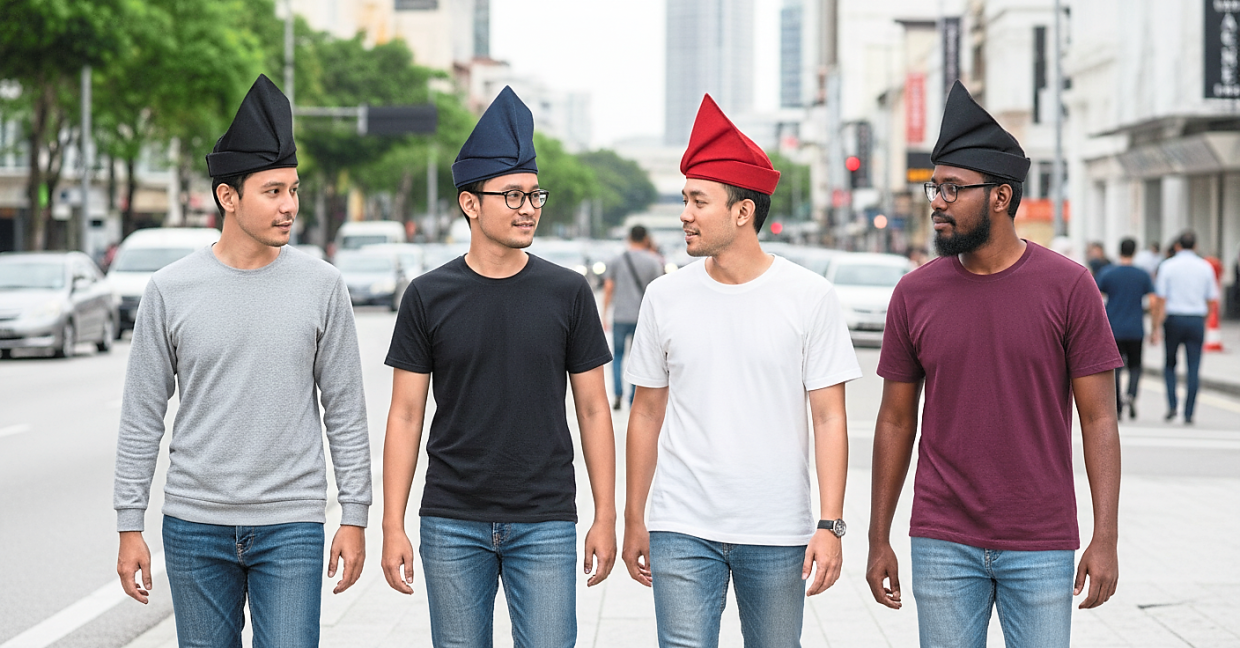
WHEN I wrote Returning to Our Roots: The Anger and Heartbreak of Young Malay Men in 2021, the sight of young Malay men wearing the tanjak (traditional Malay male headgear) caught the imagination of (non-Malay) Malaysians.
We were smack in the middle of a global pandemic and grasping the political realities of the country at that time.
These young men in Bangi, Taman Tun Dr Ismail, and various other locations throughout the Klang Valley sparked discussions on who they were and what identity politics was looking like in the country. Friends intrigued by the sight asked me: were they with Umno? PAS? PKR?
Today, men donning the tanjak, even in casual wear, are almost ubiquitous – the sight of them in the public space is no longer as jarring as before. What was considered fringe is now becoming part of the daily conversation, even among the Malays of the business and professional elite who previously would find this phenomenon an oddity.
In fact, last year there was a tanjak exhibition in Pavilion Damansara Heights, a mall in a high-end location in Kuala Lumpur catering to Malaysia’s rich.
At a recent reading event of my book, Malayland (Ethos Books and Faction Press, 2024), at Riwayat bookshop in KL, one of the panellists was Tengku Ahmad Ridhaudin, or Ku Din, who is known in silat and keris circles. He enthralled the audience with his theories on DNA, Malay identity ,and Malaysia, while wearing full traditional Malay regalia. The audience may not have agreed with what he said, but they were intrigued nonetheless.
Not that “Malay-Malaysia” has ever left the public’s consciousness, but as Malaysia pursued its economic and development goals throughout the years, Malay culture and tradition fell by the wayside for a while.
Lately, Malayness has come back to roost in its country, making a resurgence in great earnest post-2018, when Barisan Nasional lost its hold on the country.
But 2018 was not only a watershed in Malaysian politics; it also marked the culmination of a huge culture war between the so-called Malay-Muslim conservatives – who were feeling under siege – and the secular, liberal elites.
Hedged in
Why do (some) Malays feel they are under siege?
This has always been asked and bandied about from the day I entered the media as a journalist and editor in the early 2000s.
How could a demographic that is a majority in this country – that has policies and benefits tailored for them – say that they are neglected and persecuted for being Malay and Muslim?
To understand any ethnic community in Malaysia, and everywhere else, you have to learn about their lived realities and environment.
As Jon E. Fox and Cynthia Miller-Idriss’ paper titled “Everyday Nationhood” puts it, one’s national identity and connection to nationhood are shaped primarily by one’s environment and everyday life.
The “Ordinary Malay” is not part of the upper echelon of Malay society – he or she is working as part of the middle class.
Ordinary Malays view our sultans and their lineages with some reverence because they are a symbol of Malayness. However, they are not blind to the realities of life: working at all sorts of jobs to support their families while facing the perception that Malays are lazy.
Many also feel wronged by governments that they feel have only been using them for votes and political support. And when elections are over, they go home to uncertain futures.
The bumiputra, the majority ethnic group, account for 70% of the bottom 50% of the income bracket. Interest groups cherry- pick such statistics, citing historical income inequalities.
It is undeniable that poverty eradication has been impressive, but the Covid-19 pandemic reversed some of these gains, causing the absolute poverty rate to increase to 6.2% in 2022.
When examining ethnic groups, the bumiputra community has consistently shown higher poverty rates compared with Chinese and Indians, despite the narrowing of the income gap among these ethnic groups.
As reported, a recent World Bank study also found that “the differences between poor and rich bumiputra are much larger than the differences between the average bumiputra and the average non-bumiputra”.
The class clash between the better-off, more connected Malays and their lesser brethren is stark. They also feel that it is “a war” with the non-Malays, who are presumed to have more.
Threatened men
If we stretch this further to the dimension of gender, economic challenges could partly explain the rise of toxic masculinity among Malay men.
I think one of the reasons why Malay men feel the pressure to express their masculinity and – in some cases – embrace extreme ideas of manhood is because they feel their foundation as a man is being threatened.
This should not require a lot of imagination. Men are culturally and traditionally expected to be breadwinners. And when this role is not sufficiently fulfilled, they feel a major aspect of their existence missing.
It is easy for Malay men to feel under siege. While there is a decrease in (Malay) women in political leadership roles, there has been an increase in some key corporate leadership positions held by women in Malaysia, with 57% of women holding chief human resources officer roles, up from 55.1% last year.
As much as 16.3% of women hold chief executive officer and managing director roles, marking a 4.2% point increase from 2024.
On Threads, many Malay women acquiesce to traditional roles, though many more of their peers demand their rights and justice.
Malay women also appear to be quite woke, in spite of their conservative attire, so they will give the men on social media a good trashing. The few Malay men who fight back against these women on Threads tend to have fewer than 100 followers and are anonymous.
The bottom line is this – the beleaguered Modern Malay Man now has to play many roles: father, husband, lover, abang sado (muscular man), and sex god. And when women challenge these roles, his psyche might break.
For my research I spent the past five years talking to young Malay men of differing classes and backgrounds. In the past two years, I have met a few crypto boys who may be Westernised … but they are here to make money.
There is this one guy I met quite regularly. He is fit, lean, soft-spoken but masculine and in his 30s. He is a young man; hence he is naturally assumed to be virile. After a few months of talking about this, he invited me to follow his Instagram account.
Kaboom. Bentleys. Chivas. Every day there was a cigar.
His parents are M40 (middle income group) professionals, and he went to a local college. He is sharp and his whole life was in his laptop, ledger, passport, and QR codes.
“There’s no hope in Malaysia,” he said to me.
“What do you really do?” I asked.
“I fix things for clients, wherever they are. I guess I am a trader. One day, I will live across borders. You should get to know us,” he said.
So I asked: “You are gonna be like the Malays who left Malaysia to work as a professional or at a menial job?”
He was shocked. “I’m not going to be a waiter or janitor, if that is what you mean.” He looked at me and smiled. “I have money….
However, for all the sophistication, when it comes to gender dynamics, these crypto boys want traditional wives. The crypto world is only for hard men – men who live in a parallel universe, where crime is blurred and darkness protects them.
Still, the idea of eking out a living and coming home to a welcoming wife ready with a dinner spread is attractive. It is an appealing image – a hijabi wearing a scarf with its ends flapping in the air, a house smelling of scented candles, cooking the best daging salai, waiting for her husband, the Alpha Malay Man.
The weak Malay man?
If the crypto boys are sexy, then you also have the disenfranchised working-class Malay boys.
In Malayland, I mention an interview with a young Malay man who at one point considered himself a socialist and activist but who is now right-wing like his friends.
They perceive that everything they fought for went south.
The text below is derived from our exchanges in Malay on WhatsApp and email dated March 3, 2021.
“Masculinity today, my friend said, is a mess. Malay men do not even know what is toxic and manly anymore.
“To be a man is an honour,” he said, but he felt the examples he and his friends had were dishonourable.
“We are in the era of post-masculinity, where men who are brave, strong, and disciplined, and who do not want to be weak are not seen as assets in life.”
To them, a real man’s job is to procreate and a woman is “needed” to give birth to children.
But today, their manliness is being questioned.
That they are struggling to even support their parents, families and even themselves is a serious blip on their masculinity. They could not even be proper sons, so how could they be men?
So with their masculinity questioned, for him and his friends, whether they were physically weak or not, they had to be strong.
Right-wing politics provides them the space to protect themselves, their land, their homes, families, and country against their enemies.
“Malay men need a code of honour. Maybe there is a flaw, but there is a bigger problem – our political identity must be prioritised. The Heartland Malay men, or suburban Malay, sense that the Malay direction is confused, and it is a serious matter for them as men.
“Now, why are toxic traits like infidelity, rape, molestation, and bad boys the purvey of the Malay heartland and suburbia only? It cannot be that everything wrong in the world is the fault of Malay Muslim men?”
He continued, “As a man, if you do not experience this crisis, I do not know what to say. We have become a careless, mindless generation. That is why we are weak.”
Toxic masculinity, characterised by the reinforcement of traditional gender roles and aggressive leadership, appeals to voters and these young men I met, who were threatened by social change.
It also discourages female and non-conforming participation. These, however, deepen gender divides in politics and shape views on power and authority.
After all, in Islam, the role of the male in a household, it is stressed, is being a good leader and provider.
In an increasingly modern and woke world, where the male identity is challenged, asserting their role and rights as a Malay man – and Muslim too – is all too attractive.
But this is not happening only in Malaysia. This is a global experience that we are all observing now, as we witness genocides across the world and trigger-happy older men in power ordering strikes against the innocent.
The Ordinary Malay wants out of the mess, and the only way to do so is by embracing what they see as their true nature – a nationalist Malay who puts religion and ethnicity first.
Dina Zaman is co-founder of Iman Research, a think tank studying society, religion and perception. The views expressed here are entirely the writer’s own.
The full article was originally published on Stratsea, an online platform that publishes analyses and insights by South-East Asian experts and professionals.





